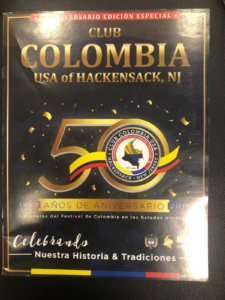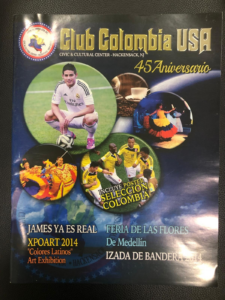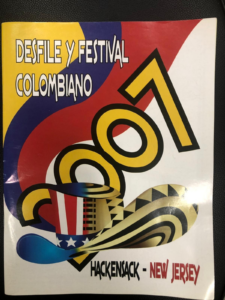Colombian Independence Day Festival: Hackensack
Cristina Escobar
with the collaboration of Jorge E. Meneses and Hernán Chica (in memorial)
While eating pandebono (cheese bread) at one of the Colombian bakeries in Hackensack, Jorge, one of the main organizers of the Festival de la Independencia de Colombia, and who was president of the organization responsible for the event at the time we met, told me about the history and all the work behind this traditional festival. He had already given me a tour of the city, which he knows very well after serving two terms (2005-2009, 2009-2013) as a city council member and as mayor for two of those years.
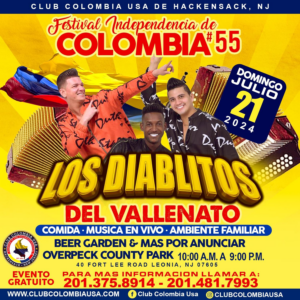 The preparation for the festival starts very early in the year. In January, Jorge was asked by the business intermediary who organizes U.S. tours for Colombian bands, which one the organization wanted to bring over this year. The selected band must be good and well-known, like the ones the organization has brought in the past, but money is always an issue. For 2024, there were two offers that Jorge and the other organization members had to weigh. Still, by early May, the group had selected one, and the announcement of this year’s festival on the group webpage and in the media was already out.
The preparation for the festival starts very early in the year. In January, Jorge was asked by the business intermediary who organizes U.S. tours for Colombian bands, which one the organization wanted to bring over this year. The selected band must be good and well-known, like the ones the organization has brought in the past, but money is always an issue. For 2024, there were two offers that Jorge and the other organization members had to weigh. Still, by early May, the group had selected one, and the announcement of this year’s festival on the group webpage and in the media was already out.
In addition to booking the band, the sponsors needed to be contacted, permits from the county needed to be obtained, the police needed to be notified, insurance bought, advertising done, food places sold, portable bathrooms arranged, etc. “Fortunately,” Jorge says, “there is a group of five young guys, well… not really, but in their thirties and forties, who have all the energy to do all that.” In addition to the five board members, there is a group of 15 to 20 volunteers. The preparation goes on for months until the third week of July, when thousands of Colombians and other Latina/os, not only locals but also from the surrounding towns and cities, gather at Overpeck County Park in Leonia, N.J., Bergen County, to participate in the Colombian Independence Day Festival. People start arriving in the morning, before the festival opening at 10:00 A.M. It is a nice time to celebrate, listen to music, sing, and dance. People bring their families, eat Colombian food, meet friends, and enjoy a nice day at the park.
Colombian consuls, the mayor of Hackensack, city council members, Bergen County Commissioners, Senators and even the governor of New Jersey might attend. In Jorge’s words, “around 1 pm we start the program with the U.S. and Colombian national anthems, remarks from the president of the Club and whoever is running for the County that year comes to greet everyone and to remind them to vote for them.”
Local bands would play as supporting acts, including a Latin American band where Jorge plays the bass. Local folkloric groups like Orquídea de Oro and Azucar, composed mostly of children and run by devoted volunteers, would dance for the public. Around 7 pm, the main group would perform, to the crowd’s delight. The band would play for 1½ to 2 hours, and then people would go back home already thinking about next year’s event.
This festival in Hackensack celebrated its 50-year anniversary in 2019, a year when a well-known Colombian band was brought up and shuttle buses had to be hired to help the crowd go from distant parking lots to the main event. The work done by Jorge and the other organizers is voluntary; and as in Hackensack, the festival is free for the public, unlike other commercial events now common in various cities with large Colombian immigrant communities which bring bands from Colombia and other Latin American countries. While the total cost of the festival can be very high ($60,000 to $80,000 in 2023), the goal is not to make a profit but to be able to pay the expenses. After all those months of preparation and hard work, the organization might only receive $3,000 to $5,000 in revenue.
It all started in 1969 when a small group of Colombians, accompanied by some Ecuadorian immigrants, gathered at Foschini Park in Hackensack for a family picnic to celebrate Colombian Independence Day. Having already requested a permit from the city, they raised the Colombian flag, sang the Colombian national anthem, and enjoyed their time at the park.
I had heard part of the story many years ago while doing research on immigrant organizations and had gone to Hackensack to talk to Hernán Chica, who was the president of the Colombian organization at the time. We also sat in one of the Colombian bakeries in Hackensack and he, accompanied by his teenage daughter, told me what he knew about the story of the organization and the festival. When I decided to write this piece, I immediately tried to contact him again but was given the sad news that Hernán had passed away (on 4/16/2023) in Colombia, where he had lived the last few years. I felt honored and fortunate to have had the opportunity to talk to him. With the organization’s approval, I include part of the interview here.
According to the story Hernán told me on that occasion, after gathering a few times at the park to celebrate Independence Day with a ceremony, a barbecue and a soccer game, Colombian immigrants formed an organization. “It was created with a patriotic principle but became one to solve needs (…) When something happened, there was a way to send a funeral wreath, or to help somebody who did not have enough to pay the rent, or somebody who had arrived recently, or things like that (…) It continued to grow, and, aside from the soccer games and helping with immigrants’ needs, they also started to make bailecitos para tomarse sus aguardienticos, me entiende? (dance parties and have some drinks, you know?) and to participate in other events, because they were already receiving invitations from other communities, like Paterson.” Eventually, the organization started with a festival in the same Foschini Park every year. Lacking a stage, they used to rent a large truck for this purpose and later, they started bringing Colombian bands to play.
Colombian immigrants had been arriving to the area in the 1960s, as in many other industrial cities of the northeast, because the low salaries in struggling industries were not attracting domestic labor so immigrants from Latin America and the Caribbean were filling the void. In some places, such as New England, Colombians had been directly recruited by the textile industries, but in many other places, such as New York, Philadelphia, and New Jersey cities, they had been arriving following networks of relatives and friends who told them about the available jobs. Among those early arrivals to Hackensack were people from the northern Colombian Caribbean city of Barranquilla, and from Medellín, but there were also some from other places. By the 1970s and 1980s, the Colombian immigrant community had become the largest Latina/o group in Hackensack, followed by Ecuadorians, who have since grown to become the largest Latina/o group in the city.
Ecuadorian immigrants have been close to the Club Colombia since the beginning, and still today one of them does critical volunteer work for the festival. At some point, in the early 2000s, there was a proposal to join forces with other Latina/o immigrants in Hackensack to create one large “Hispanic festival”, something that politicians and authorities in this city and in many other places tend to favor to facilitate the distribution of funds. However, neither the Ecuadorians nor the Colombians were unified in supporting this decision. Colombian immigrants continued with their festival and Ecuadorians created their own celebration. On January 1st they celebrate La Virgen de la Nube (the Virgin of the Cloud), a tradition from the southern provinces of Ecuador, Cañar and Azuay, where many Ecuadorians who migrated in the 1970s and 1980s come from. On January 1st, they honor the Virgin with a parade, a mass, traditional music, and dances.
For Colombians, the idea of creating a festival to celebrate Independence Day, not only in Hackensack but in other cities, has a patriotic and nostalgic element, but the origin of these festivals owes also to the presence of Colombian immigrants from Barranquilla and other cities on the northern coast of Colombia which celebrate, in March, the Carnaval de Barranquilla, now considered by the UN to be a World Heritage event. This carnival, which is really a festival of festivals, includes many bands, in addition to comparsas, which draw from their Afro-Colombian tradition. The festival in Flushing Meadow Park in Queens, which ran for 27 years and had become the largest Colombian organized gathering (attracting hundreds of thousands of people), was also started by an immigrant from Barranquilla (1982) who replicated the idea of bringing various bands into a single festival. After three years it was inherited by a Colombian immigrant organization which continued it as a Colombian Independence Day celebration until 2009. In other cities, the festival started small. A group of families recruited by the textile industry in Central Falls, R.I., in the mid 1960s, which also included people from Barranquilla, organized a mini-festival in the basement of a building which they rented for their social gatherings. They had music, food, and a beauty contest. This festival did not grow as it did in Hackensack or in New York, and Colombians eventually started to celebrate their Independence Day with a large parade.
Over the years, as colonies of Colombian immigrants grew, various other communities in different localities (Dover and Elizabeth in New Jersey, for example) developed their own festivals, copying and learning from each other. Over time, however, many of these festivals have been suspended for various reasons (economic problems, the retirement or death of the main organizers, city redevelopment and the elimination of the spaces where festivals used to take place, and even, in one case, the city demanding that the organizers pay a very large sum to hire police to control those attending, who had created some trouble the previous year). Members of the Club Colombia in Hackensack, who claim to have been the first ones to organize this festival in the United States, have been able to maintain it as a free, community-organized event year after year for over 50 years.
T he Colombian festival in Hackensack is part of a tapestry of celebrations that Puerto Ricans, as well as immigrants from Latin America and the Caribbean, have developed in various cities of New Jersey over the years. Along with the Puerto Rican parade and festival in Jersey City (1961), the Colombian celebration is one of the oldest, but with the increase of Latin American migration in the last decades, more and more of these celebrations have been instituted, including the Peruvian parade in Passaic, Clifton, and Paterson (1986), the Dominican parade festivals in Perth Amboy, Paterson, and Elizabeth, etc.
he Colombian festival in Hackensack is part of a tapestry of celebrations that Puerto Ricans, as well as immigrants from Latin America and the Caribbean, have developed in various cities of New Jersey over the years. Along with the Puerto Rican parade and festival in Jersey City (1961), the Colombian celebration is one of the oldest, but with the increase of Latin American migration in the last decades, more and more of these celebrations have been instituted, including the Peruvian parade in Passaic, Clifton, and Paterson (1986), the Dominican parade festivals in Perth Amboy, Paterson, and Elizabeth, etc.
In Hackensack, the festival and the group of Colombian immigrants that organize it have changed over the years, but the mid-1990s was a period of important transformation. Internally, there was a generational shift because the initial members of the organization were getting old; some had retired, and some had gone back to Colombia or to live in Florida. They were happy to pass the baton to a new generation of Colombian immigrants and it was then, in 1995, when Hernán and Jorge joined the group. “The elders who were there [in the organization] were tired, and when we arrived, two guys in our 40s, they saw the opportunity to get out,” says Jorge. In more general terms, life had not been easy for Colombian immigrants in the United States because their name had already been associated for more than a decade with drug dealing, violence, and illegality. “Every week you would hear ‘Colombian national selling drugs is caught in…somewhere’,” Jorge continued “it was a terrible time…. so, I was thinking there must be a way for us to change that, showing Colombia’s good things; the cooking, the dances, the music.”
Among the first changes Hernán and Jorge made when they entered the organization was to find a new name, which the original members had changed from “20 de Julio” to “Amigos de Barranquilla” (Friends of Barranquilla) because they were all from that city. Hernán and Jorge, both from Medellín, wanted something more inclusive and proposed the name Club Colombia USA, a name that the organization has kept. Another important change was the extension of the celebration to include not only the festival but many other events. This was Hernán’s big project when he became president. In the year 2000, he initiated La Semana Cultural (Cultural Week), which included a Colombian art exhibit at Bergen Community College, a Colombian Night, presenting folkloric dance,
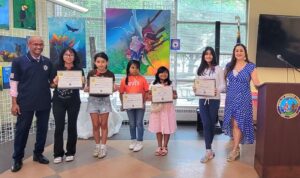
Colombian music, readings, and poetry events. “That night we invite the mayor, and other personalities who want to come and we do that in the middle of the art exhibit.” The week’s activities also included a gala party and a soccer tournament for kids. “People come from Queens, Staten Island, Jersey City, Union City, Elizabeth, Paterson, (…) we raise the flag, and in the afternoon, we start the soccer tournament for kids; and we give them trophies, and we give them lunch and they come with us to the raising of the flag at City Hall.” The Semana Cultural used to end with the festival on Sunday. Over the years, it has become difficult to continue with all these activities, but the organization has kept the art exhibit, which runs every year during July.
“There was a time”, Hernán said, “when the city did not charge for the permit to do the festival and there was liquor, beer sale; however, because it got out of hand, the city halted the beer sale and started charging”. As the festival grew, in addition to the city and the police now charging to be present, the use of Foschini Park for the festival became complicated. This was so especially when the vacant lots that had been used for parking were built into office spaces as part of the large transformation the city had experienced since the 2010s, as Jorge showed me in our city tour. While some of these problems contributed to the suspension of other festivals, in Hackensack they were able to continue. In 2014, the members of the Club decided to move the festival to Overpeck Park, managed by Bergen County, which is larger, has a built-in stage, is more accessible and has better parking. In Overpeck Park, they can also include a beer garden, which only people of drinking age have access to; drinks can only be consumed inside.

Until 2019, the Colombian organization edited a magazine featuring important Colombian cultural, sporting, and other events, where sponsors’ advertising was included for a fee. Those sponsors included large patrons such as the local hospital and Western Union, as well as many Colombian and other Latina/o local businesses. The magazine, with a print run of 2,500 to 3,000 copies, was distributed for free a few days before and during the festival and was another mechanism to finance the festival. However, the magazine requires the demanding work of contacting and visiting every client to get the sponsorship and then distributing the printed issues. This work, which the organization’s elders used to do, had fallen lately on the shoulders of the main organizers who decided to suspend it after that year.
The TV and radio used to be very important, too. Local TV channels 41 and 47 used to send prominent people at the stations to serve as event marshals, and the radio “was huge!”, Jorge says. But that has also changed, and now everything requires having “dollars in hand (…) and maintaining this is getting difficult.” Even though one of those TV channels invited them to talk about the festival, that is very different from the sponsorship and the presence that the TV channels used to have at the festivals. Now, the festival organizers depend mostly on social media for advertising.
Magazine Covers
Excluding the years 2020 and 2021, when the pandemic prevented them from having the festival, on only one other occasion did the Club Colombia from Hackensack decide not to run the festival. It was in the year 2000, when Colombia faced a political and economic crisis, and an agreement between the government and guerrilla groups operating there was difficult to achieve. That year, instead of a festival, and echoing efforts in Colombia and in many places in the United States with Colombian immigrant communities, the Club Colombia of Hackensack organized a large march for peace.
Jorge says that the demanding work for the festival is tiring at his age. “Now I understand them”, he says, referring to those elder members who were happy to let Hernán and Jorge get involved in the leadership of the organization. Jorge is happy to delegate many tasks involved in the organization of the festival to the younger volunteers, although he still maintains crucial contacts, which he has personally built over the years with sponsors and city authorities. He continues because he gets a lot of non-tangible rewards from the festival. Like the time when the festival’s main feature, the group Orquesta Canela, a women-only band from Cali, Colombia, shared the stage with little girls who came with their families to be part of the festival. Standing a few feet from the band members, the girls were amazed to see women playing timbales, drums, trumpets, piano, etc. In addition to the music, which Jorge loves, and the opportunity to perform with a local band, the satisfaction of seeing those girls having that musical experience, for example, or the satisfaction he always gets from making people happy for one afternoon, is what moves Jorge to carry on with the festival year after year. Talking about the original goal of promoting a more positive image of Colombia, he says, “that was the main goal, and we feel that we accomplished it”.
All material is copyrighted by the author, 2025.
Users may cite with attribution.
